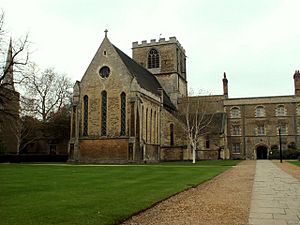St Radegund's Priory, Cambridge facts for kids

St Radegund's Priory, Cambridge was a Benedictine nunnery in Cambridge, Cambridgeshire, England. A nunnery is a place where nuns (women who dedicate their lives to religious service) live together. This priory was started before 1144, probably in the late 1130s. It was closed down in 1496 by John Alcock, who was the Bishop of Ely.
Contents
History of the Priory
Who Was St Radegund?
Radegund was a princess from the Frankish kingdom in the 6th century. She decided to live a religious life and founded a monastery called the Holy Cross in a place called Poitiers.
Land for the Nuns
Between 1159 and 1161, Malcolm IV of Scotland gave some land to the nuns. He was known as the Earl of Huntingdon at the time. He gave them 10 acres of land next to an area called Grenecroft. This is where the nuns built their church. The church was dedicated to St Mary and St Radegund. This dedication was likely because Malcolm had visited Poitiers, which was a special place for St Radegund, in 1159.
How Jesus College Began
Jesus College was founded in 1496 by Bishop John Alcock of Ely. It was built on the very same spot where the nunnery used to be. It is thought that the nunnery was changed into a college because it needed a new beginning.
The full name of the college is quite long: "The College of the Blessed Virgin Mary, Saint John the Evangelist and the glorious Virgin Saint Radegund, near Cambridge."
Nunnery Buildings Become College Buildings
When Jesus College was started in 1496, it took over the buildings that belonged to the nunnery. For example:
- The nunnery's church became the Chapel for the college.
- The Cloister, which is a covered walkway, was kept.
- The nuns' dining hall, called the refectory, became the College Hall.
- The house where the prioress (the head nun) lived became the Master's Lodge.
These original buildings are still at the heart of the college today. They give Jesus College a special, old-fashioned feel that makes it different from other colleges in Cambridge. Soon after the college was founded, a library was added. Bishop Alcock also changed the Chapel quite a bit, making it smaller. The Chapel was first built in the mid-12th century, making it the oldest university building in Cambridge that is still used today.


